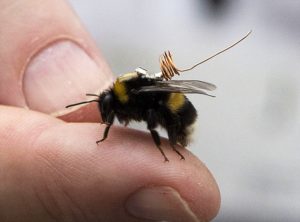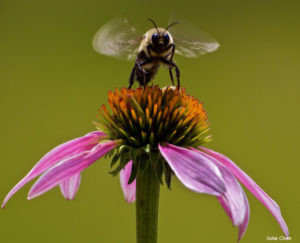A bumblebee is any of over 250 species in the genus Bombus, part of Apidae, one of the bee families. This genus is the only extant group in the tribe Bombini, though a few extinct related genera are known from fossils.
Source: Wikipedia
- Bumblebees are large, fuzzy insects with short, stubby wings. They are larger than honeybees, but they don’t produce as much honey. However, they are very important pollinators. Without them, food wouldn’t grow.
- There are over 255 species of bumblebees, according to the Integrated Taxonomic Information System (ITIS), so bumblebees can be many sizes. The largest is the queen of the Bombus dahlbomii, which can grow up to 1.6 inches (4 centimeters) long. This is three to four times longer than the American bumblebee, according to Scientific American.
Source: livescience.com - The bumblebee is peaceful and not aggressive, even compared to the honeybee. They only attack people when they are threatened.
- Bumblebees are social animals and colonies can contain up to 150 individual bees. This is however quite small compared to honeybees that can have nests with over 50,000 bees.
- In Native American symbolism, the bumblebee represents honesty, pure thinking, willingness, and drive.
Source: onekindplanet.org - The average mass of pollen and nectar carried by bumblebees returning to the nest is around 25% of their body weight. However, some bumblebees fly back carrying as much as 75% or more of their body weight!
- Bumblebees hibernate underground.
- Bumblebees will not die if they use their sting, whereas honey bees will.
Source: naturemappingfoundation.org - When they’re fully grown, the male bees fly off, never to return to the nest. The new queen bees also fly off to mate but may return to the nest at night.
- They flap their wings 200 times per second, which comes in handy when it gets hot inside the next.
- They leave smelly footprints on flowers. This lets other bees know they shouldn’t bother looking for nectar there. The footprints also help bees find their way back to their nests.
- The largest bumblebee in the world is the giant bumblebee (Bombus dahlomii), which lives in South America and whose queens have the nickname “flying mice.”
Source: care2.com - Bumblebees can reach ¾ to 1 inch in length.
- Lifespan depends on the type of bumblebee. Drones will die immediately after reproduction. Worker bees can survive a couple of months. Queen lives for one year.
- Only queen and worker bees have stingers. Besides the lack of stingers, drones can be identified by size – they are the smallest type of bumblebees in the colony.
- Bumblebees are mostly attracted by blue and violet flowers.Source: softschools.com
- Bumblebees only live for one season before they die.
- Bumblebees can sting more than once.
- About 46 species of bumblebee can be found in North America.
- Did you know that about 78% of our plant and trees need pollination. Bumblebees and honeybees and all bees need to be protected. Without them, we as humans will struggle to survive and may not even survive at all.Source: easyscienceforkids.com
-

Ecologists at Kew Gardens in London are attaching tiny tracking backpacks to bumblebees in order to monitor their behaviour.
Source: Daily Mail - Commercially traded bumblebees have become big business during the past two decades as demand for bumble bee-pollinated berries, peppers and, especially, hothouse tomatoes have skyrocketed.
- According to an article, “The Buzz About Bumble Bees,” in the current issue of National Wildlife, four once-common, widespread North American species have vanished from large portions of their former ranges. A fifth may already be extinct. Scientists report similar losses across Europe, South America, and Asia.Source: nwf.org
- Scientifically named Bombus affinis, this bee was named for the red patch in its abdomen. It took much longer than expected to put this bee into the list of endangered species list due to the tossing and turning in Trump’s administration. The original listing date was set for 10 February 2018, but it was not until yesterday that it was listed.
- Xerces Society director of endangered species Sarah Jepsen said: “We are thrilled to see one of North America’s most endangered species receive the protection it needs. Now that the Fish and Wildlife Service has listed the rusty-patched bumble bee as endangered, it stands a chance of surviving the many threats it faces — from the use of neonicotinoid pesticides to diseases.”
- Human encroachment led to the subsequent loss of their natural habitat which played a significant role in the bee’s declining population. The classification will foster the conservation of tall grasses and protection of grasslands that the bee’s and other pollinators naturally thrive.
According to National Geographic:
“The rusty-patched bumblebee (Bombus affinis), once a common sight, is “now balancing precariously on the brink of extinction,” according to the U.S. Fish and Wildlife Service. Once thriving in 28 states and the District of Columbia, but over the past two decades, the bee’s population has plummeted nearly 90 percent. There are more than 3,000 bee species in the United States, and about 40 belong to the genus Bombus—the bumblebees. - While saving bees might not be an essential task at hand for several individuals, approximately 128,000 people firmly believe that conservation efforts should start sooner rather than later and, therefore, they signed an agreement urging the listing of the rusty-patched bumble bee.
Source: thinkinghumanity.com







